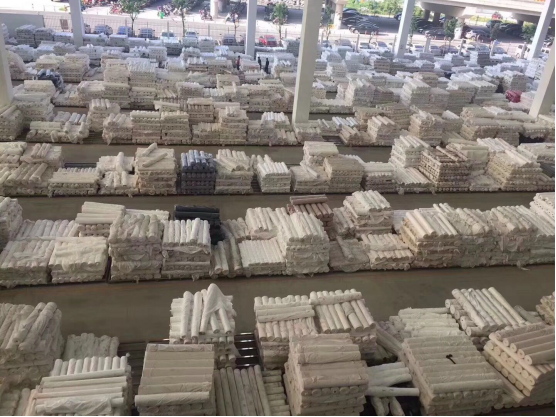In the past,
What kind of cloth did the trader want?
The gray cloth factory directly paid for the goods,
The printing and dyeing factory successfully shipped dyed fabrics.
Nowadays,
what kind of cloth do traders want?
The gray cloth factory has cash queues waiting for goods,
The printing and dyeing factory waits in line, etc.
Many cloth bosses have been deceived. Nowadays, the market atmosphere is obviously peak season, and gray cloth is hard to find in the market. The bosses are confused. Put it this way: “Any kind of fabric is easy to sell in the market now, as long as you have the goods to sell!” The upstream market is booming, and the downstream printing and dyeing market has also entered the peak season of the year. News of rising dyeing fees are coming one after another. In March alone, dyeing factories have successively Three rounds of price increases were released. Entering April, as the price of dyes continues to rise, the rising momentum of dyeing fees does not seem to have stopped. “Four consecutive increases, five consecutive increases…” has gradually become a fact. However, while prices are increasing, , What makes the cloth boss even more painful is: the dyeing factory has not yet delivered the goods on time!
The position is liquidated! The card has not been opened after more than ten days in the warehouse!

(The dyeing factory has piled up gray fabrics)
A trading boss Shen in Shengze complained to the author: “It is too difficult to do business this year. It’s been more than ten days since I bought several kilometers of fabric and I still haven’t opened the card. At this rate, I won’t be able to get the goods for 20 days. It’s a big headache!”
In fact, it’s so frustrating! Boss Shen’s big problem is also a pain in the hearts of many traders now. Since the environmental crisis in 2016, printing and dyeing as a highly polluting industry has attracted much attention. After two years of industry reshuffle, some “scattered and polluting” printing and dyeing companies have long been eliminated. Since this year, environmental protection rectification has continued to escalate:
On March 31, 79 printing and dyeing companies including Shengze, Pingwang and Taoyuan: 53 dye vats were seized and 232 equipment were dismantled;
4 On March 4, Binhai Industrial Park in Keqiao District, Shaoxing implemented the suspension of production for rectification of 10 printing and dyeing companies and 5 industrial communities in accordance with the “nine uniform” fire safety rectification requirements;
The Ministry of Environmental Protection recently announced that companies that cannot upgrade and transform to meet emission standards will be closed before the end of September this year. The State Administration of Work Safety of the State Council also announced that it will carry out a major inspection of production safety from July to October. Chemical plants in 34 provinces, municipalities and autonomous regions in China will be “inspected”. The continuous elimination of backward production capacity has also caused the liquidation phenomenon in the printing and dyeing industry to be more serious during this year’s peak season than in previous years.
“Currently due to environmental protection, dyeing factories are constantly dismantling vats, market capacity has been reduced, and people are more panicked.” Boss Shen continued.
(Dyeing Factory Stops Collection Notice)
Submit Encountered “intestinal obstruction” during the period, and traders “complained”
Under such market conditions, it has become normal for dyeing factories to be unable to deliver goods! As intermediary traders, customers rush for goods day and night, regardless of morning or evening. Entrusting relationships, making phone calls, and squatting in dyeing factories have become the focus of textile workers’ work recently. For the cloth boss, the price increase is not terrible. What is terrible is that the order delivery period after the price increase encountered “intestinal obstruction”! This pressure spreads along the entire industry chain.
The order delivery date has been difficult to determine, causing traders to be hesitant when accepting orders. Mr. Wu, the owner of a trader in Wujiang, said that when talking to customers about orders now, the delivery time is at least one month. On the one hand, you have to queue up to get the blanks. On the other hand, not to mention the dyeing factory, 20 days of delivery is considered fast. Yes, if the customer doesn’t agree, they can only give up. After all, the cost of air freight is too high. If you are not careful, you will lose the profit of the order.
In addition, it not only affects traders in accepting orders, but also has an impact on weaving manufacturers. Boss Zhang of a weaving factory in Jiaxing that specializes in imitation silk said that some customers have already called us. We don’t have to rush to ship the goods, because the tens of thousands of meters it was put into the dyeing factory in mid-March for dyeing only came out a few thousand meters. The dyeing factory’s delivery speed is too slow, disrupting traders’ subsequent order placement.
One stone stirs up a thousand waves! Originally, the cloth bosses were thinking that the market would get better, but now they are complaining. Increased costs, difficulty in filling orders, and uncertain delivery times have become unspeakable pain in their hearts. Some experts say that the second half of this year will be the most brutal half of the reshuffle in the textile industry. Companies are not only facing multiple rounds of consecutive price increases, but they may not be able to buy goods even if they have money. In any case, we have finally survived the “Ice Age” of the past few years. In this “new era”, Boss Bu must hold on, and the gold left after the big waves will surely shine!
</p







